Hersonissos is one of the most popular tourist resorts in Crete, located 28km east of Heraklion. Here you will find whatever you desire. During the day you can enjoy nice beaches or water parks, drink your coffee in the seaside road, visit the local archaeological sites, stroll in the villages of Ano Hersonissos, Piskopiano and Koutouloufari, trek in the gorges of Avdou valley, visit the Lassithi Plateau and much more. Similarly, during the night the choices for entertainment are too many, with the nightclubs of the coastal road gathering most people. Hersonissos in summer is crowded by young tourists, coming from all latitudes and longitudes of the earth to enjoy their vacation.
A brief tour in Hersonissos
Before its rapid development, Hersonissos was a small harbor that served the needs of the local fishermen. Over the years the port grew and the village became a small town and a popular tourist resort. On the west side of the coastal road, 1km west of the harbor, you will find the Cape of Sarandaris with the picturesque chapel of Saint George, which is worth visiting. From there start the alternating coves of Hersonissos with the nice colored beaches. Along the coast there are many hotels, cafes and restaurants.
East of the coves you will meet the cape of Kastri, west of which the main town actually starts. Over the hill, you should visit the ruins of an old basilica with many mosaics. Just on the east is the picturesque chapel of Agia Paraskevi, part of which is built into the rock. The Church overlooks the nearby scenic port of Hersonissos with its beautiful lighthouse. Excursion boats run daily from the port, making trips to Dia island and the surrounding coast.
The seaside road that crosses the town starts in the port. There are many nightclubs, cafes, restaurants and bars on the road. Here you will find thousands of tourists partying in the nights until dawn. If you turn from the road and head north, you will find yourself in the small narrow streets of Hersonissos and after a while you will reach the main road, which has many restaurants, shops, banks, clinics, pharmacies, etc. If you walk to the east instead, along the coastal road, you’ll meet the bustling beaches of the eastern Hersonissos and the great hotels of the region. Nearby there is a water park and kart. As you head to the east, the beaches get more peaceful. There, before Cape Drapano, you will find the traditional museum Lychnostatis, which is worth visiting to see how Cretans lived in the past.
History
Hersonissos has been inhabited since the Minoan period (at least), due its good climate and the natural harbor formed east of Kastri Hill (in the location of the current port). Traces of the harbor and the Minoan settlements in Kastro and Anisaras have been found.
Later, in the Classic years, Hersonissos was an independent city, but not too strong.
In the Hellenistic times, Heronissos was the port of Lyttos city (close to today’s Kastamonitsa). It was strong and had its own currency, with a symbol of a boat. From this period, a part of a temple dedicated to the goddess Vritomartis has been excavated over Kastri Hill, where many coins, vases and figurine parts have been extracted. Around it, you still can see parts of the walls that protected the hill. In Hersonissos, excavation revealed a cemetery of this period with a large number of pottery, jewelry and coins.
During the Roman period, Hersonissos flourished and its geographic position made it stronger than Lyttos. The theater of this period is not preserved today, as its inhabitants destroyed it in order to use the stones as building materials. Lastly, in the coastal road you will see the pyramidal structure with mosaics, called Sarakinos.
In early Christian times, Hersonissos continued to dominate the region. The most important finding of this period is the basilica on the hill Kastri. It was built in the 6th century and seems to have collapsed by an earthquake. The architecture was influenced by Syriac standards and was decorated with mosaics, some of which survive in good condition. The hill was surrounded by strong walls, traces of which exist. Another basilica has been found 2km east of the port. Part of the church is covered by the sea and you'll see mosaic floors, much nicer than those of Kastri.
During the Turkish occupation, the port was used to supply the Cretan rebels. Later, it was used for the exportation of local products (oil and carob).
- 1
- 2
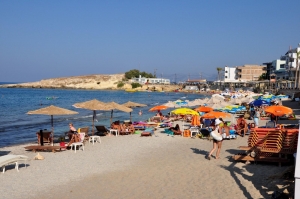
The first beach you come across east of the port of Hersonissos is a long sandy narrow beach, which is flooded by thousands of people. It is very well organized and close to the amenities of the city. However, it is inappropriate for those who do not like crowds.
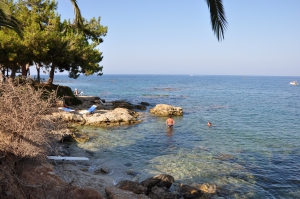
The Coves of Hersonissos are located 27km east of Heraklion, starting from Cape Sarandaris and continuing to the east till the harbour of Hersonissos. They are really beautiful beaches with calm waters, since Cape Sarandaris protects them from the northwest winds.
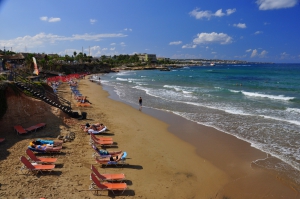
Hersonissos is a very busy, touristic town located 28km east of Heraklion. 2km east of the Hersonissos port, you'll find several nice coves, that constitute the complex of east Hersonisos beaches.
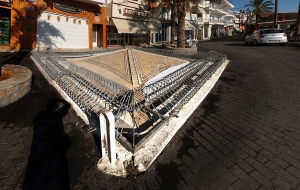
The present town of Hersonissos retains the name of the ancient city of Hersonissos or Heronissos. The town existed since the Minoan period, but flourished after the conquest of Crete by the Romans.
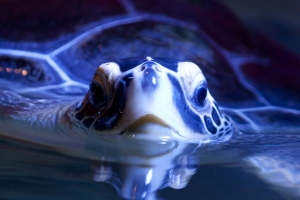
Aquaworld Aquarium has been operating since 1995 by John McLaren and is located very close to the main road of Hersonissos.
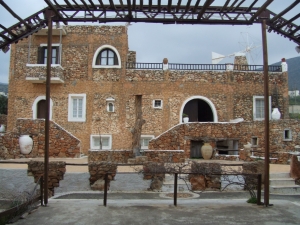
The Open-air Museum Lychnostatis was founded in 1992 by the doctor and collector George Makrakis. The buildings themselves are some of the main exhibits as they were built thoroughly with the prevalent raw materials (stone-wood-clay).
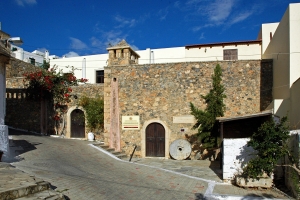
The Menelaos Parlamas Museum of Rural Life & Theano Metaxa-Kanakaki Weaving Collection, housed in a 19th century stone-built olive mill and house, was founded by the Society of Cretan Historical Studies in 1988.
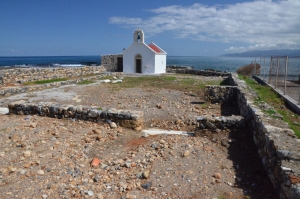
The Early Christian basilica of Agios Nikolaos is located east of Hersonissos town, at the site of the current church of St. Nicholas. The basilica of the 6th century had dimensions 50mx19m. It was decorated with a mosaic floor which is preserved in better quality than the floor of the nearby basilica in Kastri.
- 1
- 2

















































































